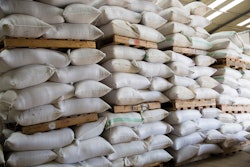
In 2016, the Institute for Feed Education and Research (IFEEDER) commissioned an economic research and analysis firm to conduct a first-ever economic analysis of the U.S. animal feed and pet food manufacturing industry’s contribution to the economy.
The result – The U.S. Animal Feed and Pet Food Manufacturing Industry Economic Contribution Study – cements that through purchases from and sales to many other industries, this segment has a large impact on the local, state and national economies.
Given generally increasing worldwide demand for protein and pet ownership rates, it’s expected that this industry will continue to thrive and contribute to the economic well-being of the United States.
- 944,227 jobs
- $297.1 billion in total sales, including $102 billion in value-added and $55.9 billion in labor income
- $22.5 billion in local, state and national taxes
“This study demonstrates the importance of the 5,715 animal feed mills and 517 pet food facilities in the U.S.,” says John Stewart, American Feed Industry Association’s manager of government affairs.
“I believe everyone was surprised by the size of our industry, both in production numbers and economics,” he continues. “More specifically, it was interesting to see how much the urban districts in the country, such as those in St. Louis, MO, contribute to the high concentration of pet food manufacturing, driving up the industry’s overall economic value.”
Stewart notes it was interesting to see the sheer amount of taxes that the industry pays – roughly $22.5 billion – across the country, supporting state and local communities as well as boosting the national economy.
Following are highlights of the study.
Stand-out states
Five states consistently rank at the top of all reported economic measures: Missouri, California, Texas, Pennsylvania and Iowa.
“These leading states all have a valuable combination of animal feed and pet food mills that drive economic activity,” notes the report.
Each of these five states are home to anywhere from 17 pet food mills in Missouri to 89 in Pennsylvania, and 149 animal feed mills in California to almost 680 in Texas. Together, the animal feed and pet food manufacturers in the top five states contribute the following total to the economy:
- 337,051 jobs
- $105.2 billion in total sales, including $37.9 billion in value-added and $21 billion in labor income
- $8.3 billion in taxes at the local, state and national level
Relevant developments
Most industries have change factors — both positive and negative — that can shift the prospects of the industry going forward. The IFEEDER study notes there are several industry developments upstream, in, and downstream from the production of animal feed and pet food that are relevant.
Animal Producing Regions: During the recent 2010-2013 drought across much of the southern plains states, there was a large impact on cattle-producing regions. Much of the traditional cattle production in Texas, Oklahoma and Kansas shifted north and slightly east to Nebraska and Iowa during the height of the drought. More recently, the case of the avian influenza outbreak in 2015 across the Midwest caused a dip in feed demand.
In both cases, the animal feed production industry saw negative economic impacts from lower feed demand, notes the report, and plans for addressing the recurrence of these types of — or similar natural — events should be refined.
Changing Consumer Preferences: Consumer preferences regarding food production continue to evolve. A shift in how and what animals are fed will cause upstream changes in how their food is provided.
Pet food is also moving toward a more “human” diet — impacting both feed and pet food production. How will this trend affect the feed industry?
According to the study, we will see demands for traceability and identity preserved (i.e., identifying and/or isolating specific characteristics, such as organic products, throughout the supply chain); a shift toward more organic foods; and changes in feed ingredients designed to improve the quality of meat and livestock products.
Policy implications
Probably the biggest impact on any industry comes from policy changes, and there are several staring down the feed industry. Immigration and the Food Safety Modernization Act (FSMA) are two top concerns, notes the IFEEDER report.
Immigration
Legal uncertainty associated with immigration and labor issues presents major implications to animal agriculture in the United States.
“Immigration impacts all of agriculture,” explains Stewart. “Feed in particular will be heavily impacted by the availability of workers in animal agriculture. Without an adequate labor force, our primary food animal customers are put in a tough position.
“There are some ideas floating around about extending the visa to a multi-year program or moving the agriculture workforce over to the U.S. Department of Agriculture, where the staff is more familiar with the needs of agriculture,” he adds.
Food Safety Modernization Act
FSMA became federal law in early 2011 and was designed to help ensure the safety of human and animal food. Food safety has been, and continues to be, a top priority of the animal food industry.
This year, the FDA has provided a few more guidance for industry documents, which are intended to provide clarity on how to comply with the regulations, says Stewart.
“The challenge facing the animal food industry is that facilities have had to be in compliance with FSMA without the benefit of these guidance documents, putting manufacturers in a tricky spot trying to interpret the regulations and hoping they will meet the FDA’s requirements when the inspectors show up,” he says.
“Since there are many ways that manufacturers can reach the same goal of animal food safety, AFIA continues to urge the FDA to take a flexible approach to its final rulemaking,” he continues. “AFIA sincerely believes that it’s FDA’s responsibility and our responsibility to ‘educate before you regulate’ the industry.”
Challenges and opportunities
The animal feed industry is regularly evolving with market conditions, adapting to consumer tastes and preferences, sifting through regulatory hurdles, and managing environmental challenges beyond its control.
Some of these challenges, including diseases like the Porcine Epidemic Diarrhea Virus (PEDv) and Highly Pathogenic Avian Influenza (HPAI), disrupted the animal agricultural industry, resulting in major economic losses.
But animal agriculture continues to evolve and address current and emerging challenges.
“Odds are good that the industry will adapt and continue to grow stronger, thereby allowing animal feed and pet food facilities to remain economically healthy,” says Stewart.
Trade is a top current concern for the industry, not only for products, but also for its customers.
“Open and fair access to global markets is essential for the success of the feed industry,” says Stewart.
“Renegotiating a fair North American Free Trade Agreement (NAFTA), maintaining access to the Chinese market and expanding bilateral agreements with Japan and others are essential for all of agriculture,” he adds.
A few opportunities exist for the industry to grow and adapt in the future, including a shift in the production and processing of livestock and poultry due to environmental conditions and regulatory forces.
Other opportunities for expansion include branching into new markets, such as the continued expansion of aquaculture.
Also, consumer demand for organic food production is likely to continue increasing in the future. This has implications not only for additional differentiation of meat and poultry production, but also supply chain identity preservation for both feed ingredients and meat and poultry products.
“Since the report’s launch in January, the AFIA staff has met with more than 100 congressional offices and roughly 80 regulators to educate them on the industry’s economic impact,” says Stewart.
For more information, an interactive map at www.afia.org/feedindustrystats provides links to 535 state and congressional district fact sheets that are useful tools for the industry to use when meeting with state or federal congressional officials. ❚



















